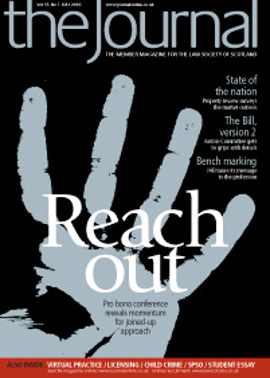Acts of kindness

The enactment of the Ure Elder Fund Transfer and Dissolution Act 2010 offers an insight into the promotion of private legislation, as well as reorganisation of charities under the Charities and Trustee Investment (Scotland) Act 2005.
Private legislation
The Ure Elder Act is a relatively rare example of a “private” entity promoting legislation. Scott Wortley’s 24 December 2009 posting on Scots Law News offers a succinct overview of Scottish private bills following devolution. Such measures seek to do something in excess of the general law as it stands; in the case of the Ure Elder Act, to effect a statutory transfer of assets and liabilities and repeal previous legislation.
It is important for promoters to establish the reasons for such objectives and for resorting to legislation. Effective pre-introduction consultation is at the heart of this. Perhaps the central document to the procedure is the promoter’s memorandum. This details the bill’s genesis, its objectives and how these will actually be implemented, seeking to explore more fully and accessibly the statutory language deployed.
Its importance is underlined by the need for the promoter to explain to the parliamentary bill committee the bill’s objectives, coupled to the reasons why the promoter embarked on legislation. Once the committee has heard evidence it will report to the Parliament. The report will be considered at a preliminary stage debate and the bill will then undergo consideration stage (if required) and final stage before being passed.
It is likely that the preliminary stage report will be the most detailed examination of the bill. It also offers the committee the opportunity to make general observations and recommendations. The Ure Elder Bill committee did so in the context of the methods of reorganising charities.
Charity reorganisation
The Ure Elder Act is the first of its kind since OSCR assumed its full regulatory role. It is guaranteed not to be the last, following the introduction of the William Simpson’s Home (Transfer of Property etc) (Scotland) Bill. Due to the future likelihood of charities created by statute seeking to promote private legislation, the preliminary stage report appropriately raised the issue of methods available to charities to reorganise. Its conclusion that statutory charities should not always need to promote private legislation leads one to consider the reorganisation provisions in chapter 5 of the 2005 Act.
Chapter 5 provides a system for charities to alter their constitutions, where these do not provide the trustees with a route to make the desired amendments. Section 42(5) states that the provisions do not apply to charities constituted by an “enactment”. The accompanying explanatory notes underlined the apparent intention to maintain the position of the legislature in relation to certain charities.
Cross and Ford’s annotations to the Act neatly describe that s 42(5) “avoids usurpation by either OSCR or the Court of Session of the role of the Privy Council... or of the legislature”. However, s 42(5) is subject to an exception that the “governing body”, i.e. the trustees, of an “endowment” under the Education (Scotland) Act 1980 may use the reorganisation provisions. The definition of “endowment” (“any property, heritable or moveable, dedicated to charitable purposes”) leads to an unhappy relationship between the 1980 and 2005 Acts, one that could significantly widen the scope for charities to reorganise in a manner not envisaged under the 2005 Act (and other regulatory requirements that may apply to specific charities). A wide definition could lead to the place of the legislature being set aside for all charities governed by statute. This seems far from what the 2005 Act intended.
The reorganisation provisions are largely based on ss 9 and 10 of the Law Reform (Miscellaneous Provisions) (Scotland) Act 1990. These sections proved not entirely satisfactory in practice (see, e.g. Mining Institute of Scotland Benevolent Fund Trustees, Petitioners 1994 SLT 785), and the current provisions are an improvement, due in many ways to the manner in which OSCR’s team deal with chapter 5 applications. However, they could themselves be improved. The Public Services Reform (Scotland) Act 2010 makes some welcome amendments, but these address very specific problems rather than provide a systematic and coherent updating. To provide clarity to all concerned, the reorganisation provisions should be fully reviewed.
The rules need to provide a flexible OSCR-led process for the vast majority of charities, while respecting the Privy Council and Parliament’s roles. Replacement of the reorganisation parts of the 1980, 1990 and 2005 Acts with a coherent, single set of rules within the 2005 Act would appear the most appropriate way.
- Alan Eccles, Associate, Maclay Murray & Spens LLP
Memorial to a pioneer
Alan Eccles writes: “The Ure Elder Act provides an opportunity to acknowledge the endeavours of Isabella Elder, whose will created the Ure Elder Fund and stands testament to a lifetime of ground-breaking programmes, particularly in women’s education. For those interested, I recommend Dr Joan McAlpine’s The Lady of Claremont House: Isabella Elder – Pioneer and Philanthropist (1998).”
In this issue
- Drop everything
- Free to give
- For the common good
- "Not for the likes of me"?
- RoS fees up for review
- Taking shape
- Criminalising children
- Split decision
- A picture's worth a thousand words
- "Duty to trade" revisited
- Law reform update
- From the Brussels office
- Join the cloud
- Combating claims in interesting times
- Ask Ash
- Party confidential
- What fresh hell is this?
- Links with the past
- Stranger than fiction
- Acts of kindness
- Scottish Solicitors' Discipline Tribunal
- Website review
- Book reviews
- Service driver
- Forecast: cloudy






